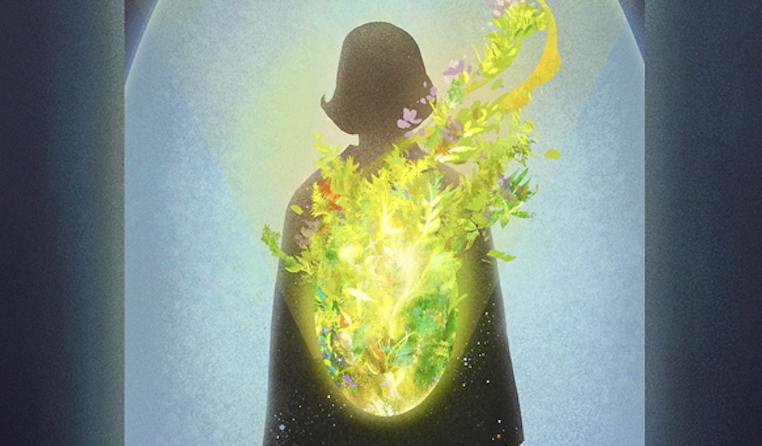Independent filmmaker Jidi Guo was initially worried about whether she would be able to tackle a topic as taboo as mental health in China. She succeeded in the end, and the result is her second documentary, Brain Fog. It took her two long years — which could have been less if not for Covid — to smoothly wrap up the film, which was released on the Chinese streaming platform Bilibili on April 21.
Raw, authentic, and poetic, Brain Fog documents the daily lives of three young women with mental disorders. Few know what to expect from the film’s title and poster, but as the old adage goes: Don’t judge a book by its cover (or, in this case, a movie by its poster). Guo’s every intention was to address Brain Fog’s central theme with subtlety, and that approach extended to the film’s moniker and promo material.

Official poster for Brain Fog by Jidi Guo
A full-time brand specialist and a managing partner at creative agency Inner Chapter, the self-taught filmmaker works on independent documentaries in her spare time. Despite being a hobby, she occasionally pulled 20-hour days while editing her latest doc.
“I think I was always quite interested in a combination of human stories and then linking it to something bigger,” shares Guo, who believes that it is possible to address broader issues by drawing out different perspectives — a philosophy that applies to both her professional and personal projects.
It Started With Africa
Hailing from Jilin province in Northeast China, Guo’s family immigrated to the Netherlands when she was just 4 years old. However, Guo moved to Shanghai a decade ago to search for new opportunities and get reacquainted with her cultural identity.
With dual degrees in new media and communications, Guo developed an interest in documentaries at college while watching films produced by Vice, Vox, and BBC. However, she didn’t think of making one herself until 2017.

Independent filmmaker Jidi Guo
It all started with an article Guo read on Chinese youth carrying out charity work in Kenya. While the volunteers’ efforts touched Guo, some cast the story in a negative light and even doubted the participants’ motives.
“I remember feeling quite pissed off,” she fumes. “I just feel like there are so many things that are negatively associated with being Chinese that I have personally dealt with.”
Such prejudices have tainted Guo’s own travels to Ethiopia and South Africa. It took her and her friends three days to convince their safari ranger that they weren’t poachers or poacher informants. Later, Guo was told that rhino poachers bore Chinese features.

Jidi Guo during a self-sponsored trip to Kenya to produce a documentary about China-Africa relations
Incensed, Guo was determined to return to Africa to conduct a deeper exploration of China-Africa relations. That’s when she first realized that text alone wasn’t a sufficient medium to tell her story.
“I felt like I can write about it all I want, but it would just not be as impactful as showing what it’s like and letting people speak for themselves.”
Assisted by her friend Philip Man, Guo was able to turn a 10-day trip into her first-ever documentary, titled Behind the Belt: A Look at China’s Cultural Influence in Kenya.
After uploading the short film to YouTube in 2017, Guo barely bothered to promote it. The film went almost unnoticed for years — until recently. At the time of writing, the video has organically accumulated more than 31,000 views.
In the wake of her first foray into documentary filmmaking, Guo has continued to be drawn to China-related topics.
Destigmatizing Mental Health Conditions
After chatting with a friend with ambitions to become a licensed therapist, Guo wanted to learn how young Chinese urbanites deal with mental health problems. Unable to find many first-hand anecdotes online, she decided to document some on her own.
“It’s very hard to imagine how to do that in other formats,” explains Guo. “I feel like, with documentaries, you can actually kind of vanish. So your presence can still be felt [by viewers], but it’s really just the subjects saying the things that they want to say without your interference.”

Jidi Guo hopes the documentary format can do justice to her subjects
Guo posted the project on social media, and soon more than 10 people reached out, willing to be filmed. Most applicants identified as women.
“Almost unanimously, they wanted to do something meaningful,” says Guo after asking each volunteer why they wanted to be on camera. “They wanted to log this somewhere and then hopefully pass this knowledge on so that other people can at least feel some sort of connection or affinity or maybe feel less alone.”
To avoid triggering trauma, Guo decided only to include those with support systems and who were stable and comfortable enough to share their experiences.
“Authenticity is my priority,” she says. “As a content creator, I get to take away [their stories] to create things I find interesting with other people, but not at anyone’s expense.”

Jidi Guo decided only to feature candidates who have support systems
Guo eventually selected three candidates from different backgrounds. Coincidentally, they went through incredibly alike diagnosis processes, almost identical, and they sometimes shared similar sentiments. Guo recalls a stirring statement from one interviewee:
“Everyone feels really terrible in the morning. Then in the afternoon, you just kind of try to move through a cloud. Evenings are marked by bursts of energy that don’t allow you to sleep. You tell yourself, hopefully, tomorrow will get better, but it ends up being a cycle.”
The film opens with shots of the three women. One by one, they put on their makeup and get ready to go out. By opening the film with an everyday scene, Guo hopes to destigmatize and normalize mental health conditions.
“Because I felt like whatever your diagnosis is, whether it’s mental health or physical health [problems], it’s like if you get diagnosed with a cold or broken leg or cancer, you’re not living with it,” she says.

A sketch of one of Jidi Guo’s interviewees who struggles with eating disorders
She adds that the opening also provides an opportunity for the audience to get to know the women as they are in real life.
“I don’t wanna create a weird reality show where people are like, ‘Hi, I’m bipolar,’” explains Guo. “If you don’t like them, you can stop watching, because if you already don’t like them for who they are, once their diagnoses come in, you probably will like them even less.”
The Art of Subtlety
As mentioned above, Guo has tried to address the theme of mental health as subtly as possible in the film, even when choosing its name.
“I wanted to capture something that is a state with some ambiguity and different levels of severity, perhaps,” she says. “It’s just like something that is kind of covering your ability to feel, to enjoy, to be productive, and to communicate with others.”
That’s how she chose the title Brain Fog, as it conveys that “you’re obviously still very much in reality, but things are clouded, or your senses are kind of numb or less sensitive to picking up on things.”
The film’s soundtrack is probably the only personal element to do with Guo herself, she reckons. ‘Shen Xian Yao’ by music duo AM444 played in her mind as she went through her footage. She believes the song’s lyrics perfectly capture the endless amount of judgment and stress faced by today’s youth.
“Don’t know what you young people are thinking these days. So messy. We always face the same issues. It’s so easy. It’s so easy to say, ‘I give up.’”
— Shen Xian Yao
Guo discovered the band back when she first moved to Shanghai. As a live music fan, she went to Yuyintang, one of Shanghai’s oldest underground livehouses, and immediately fell in love with the singer and AM444. After seeking permission to use the song in her film, the band was kind enough to let Guo use it for free.
“I was really happy,” she smiles, adding, “It was the most amazing day.”

Now that her second documentary is out, Guo sometimes checks online comments about the film, including the negative ones. She acknowledges that Brain Fog is not that visually stunning, but she isn’t discouraged. Although Guo doesn’t have an idea for her next project yet, she hopes to improve her filmmaking skills each time.
“What I prioritize is authenticity,” underscores the young filmmaker. “To me, hearing that [my work] is authentic and raw, and [knowing that my subjects] feel really comfortable sharing their experiences are more important at this point.”
Watch ‘Brain Fog’ on Bilibili with English subtitles
All images courtesy of Jidi Guo






















